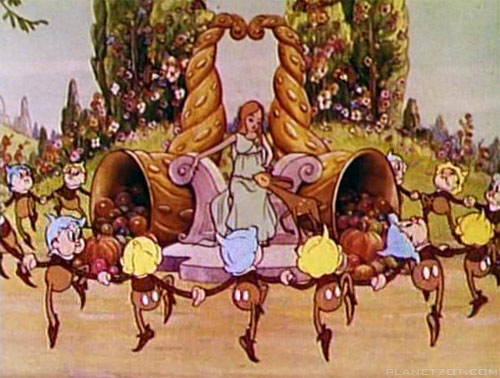Title of the work
Studio / Production Company
Country of the First Edition
Country/countries of popularity
Original Language
First Edition Date
First Edition Details
Distributor: United Artists, music by Leigh Harline, November 3, 1934.
Running time
Format
Date of the First DVD or VHS
Genre
Alternative histories (Fiction)
Animated films
Fantasy fiction
Mythological fiction
Short stories
Target Audience
Crossover (In the 30s many shorts by Walt Disney Productions were just technical experiments. Usually they were presented before the main feature movie, often for adults. Later, it was issued along with other animations from the “Silly Symphony” series, so it is hard)
Cover

The Goddess of Spring [frame] under the Wikimedia Common Rights, Date: 22 May, 2014, Source: Own work, Author: Miss Tinkertrain (accessed: August 17, 2018).
Author of the Entry:
Anna Mik, University of Warsaw, anna.m.mik@gmail.com
Peer-reviewer of the Entry:
Elżbieta Olechowska, University of Warsaw, elzbieta.olechowska@gmail.com
Elizabeth Hale, University of New England, ehale@une.edu.au

Wilfred Jackson
, 1906 - 1988
(Animator, Director)
Wilfred Jackson was an American animator, director and producer. Fascinated by the art of “moving pictures”, he decided to approach Walt Disney and offer him to work for his company for free. As the time in business was difficult, Disney hired the young excentric who much later was hailed a Disney Legend. Apart from being an animator, he had a very useful skill: he knew how to perfectly synchronize sound and picture, a technique developed (among other productions) in several Fantasia sequences. After assisting Ub Iwerks (the legendary creator of Mickey Mouse), he got promoted and became a director/co-director of many classic Disney movies, such as: Snow White and the Seven Dwarfs, Peter Pan or Sleeping Beauty. Poor health forced him to retire in 1961.
Source:
Smith, Dave, ed., “Wilfred Jackson” (entry); in Disney A to Z: The Official Encyclopedia, 4th ed., Glendale: Disney Books, 2015.
Bio prepared by Anna Mik, University of Warsaw, anna.m.mik@gmail.com
Summary
Jackson’s short animation re-tells a classical mythological story about the origins of seasons. It opens with an idyllic scene where animals, dwarfs and flowers dance around a beautiful girl, called in the song “The Goddess of Eternal Spring”. Crowned with a floral coronet by birds and sitting on a throne among nature (in the central position of the frame), she is shown as the most important (in an anthropocentric way) character in this picture. The situation changes when the earth opens and Hades/Pluto (presented as the Christian devil) appears with a demand: “I’ve chosen you to be queen of my kingdom”. He kidnaps the goddess and forces her to live in the Underworld. Persephone gets depressed, which not only causes winter on Earth, but also upsets Hades, who wants to cheer her up by giving her jewellery. That does not work. Eventually they come to an agreement, that Persephone can come back to Earth, but only for half a year, the other half she will spend in the Underworld. When she comes up to the surface, the frozen nature melts, everything comes back to life and celebrates the goddess’ return. And as the song sums up: “So now you know the reason, Why there's a winter season, Instead of eternal spring […].”
Analysis
The short is kept in the convention of operetta, mixed with jazz sequences performed in the Underworld. All dialogues are sung by characters, which exaggerates the dramaturgy of the events. The plot lacks the character of Demeter, so the conflict is set only between two characters: Persephone and Hades. The reality is polarized between the feminine and the masculine power represented by their kingdoms. The feminine is represented here by nature and life, the male element – by darkness, destruction and death. The confrontation of these two worlds brings harmony to nature: there has to be the time of winter (death), so the spring would be able to bring back the sun (life).
“Silly symphonies” in general served as an experimental platform for bigger productions – and this one is no exception. The Goddess of Spring was a test for Disney’s first full-length animation Snow White and the Seven Dwarfs released in 1937. In the short we can spot many analogies with the movie: colorful setting, playful animals, dwarfs that accompany the goddess. Some even claim that because of the existence of this animation, Snow White has to be deprived of the title “the first Disney princess”, as it is Persephone who deserves it. It can also be claimed that many visual motifs from The Goddess of Spring were later used in other animations, such as Fantasia from 1940. Even though Disney’s story about Persephone is not the most popular one, it had a great impact on later, more successful productions and served as basis to create many different fairy-tale worlds with strong mythological backgrounds.
Further Reading
Blackmore, Erin, Snow White Wasn’t the First Princess. Dwarfs, meet Persephone, “Smart News”, smithsonianmag.com, February 4, 2016, (accessed: August 17, 2018).
Bradley, Edwin M., The First Hollywood Sound Shorts, 1926–1931, Jefferson: McFarland, 2009.
Cavalier, Stephen, The World History of Animation, Oakland: University of California Press, 2011.
Cohen, Karl F., Forbidden Animation. Censored Cartoons and Blacklisted Animators in America, Jefferson and London: McFarland & Company, Inc., Publishers, 1997.
Hayes, Elizabeth, "The Persephone Myth in Western Literature", in E. T. Hayes, ed., Images of Persephone: Feminist Readings in Western Literature, Gainesville: University of Florida Press, 1994, 1–19.
Meritt, Russel and J. B. Kaufman, Walt Disney’s ‘Silly Symphonies’: a companion to the Classic cartoon series, Gemona: La Cineteca del Friuli, 2006.
Moen, Kristian, Film and Fairy Tales. The Birth of Modern Fantasy, London, New York: I.B. Tauris, 2013.
Smith, Dave, ed., “Wilfred Jackson” (entry); in Disney A to Z: The Official Encyclopedia. 4th ed., Glendale: Disney Books, 2015.
Addenda
Many language versions.


